Young children often learn about the world around them through exploration and experimenting with their senses. Next time you and your child go for a walk, watch how they look at, listen to, touch, smell, and even taste almost everything they come into contact with. It may gross you out, but to them this is how they learn!
When a child’s senses are stimulated while learning, there is a better chance of memory retention. Sensory play builds better and stronger neural pathways, which is crucial for future learning.
How do you incorporate all of that into educated play? I present to you: The Sensory Bin... Or the Exploration Bin, as we like to call them.
Sensory bins can be a great way for children of almost any age to learn via their 5 senses; and through sensory play, children have a better opportunity to build their science, math, fine motor, and language skills, while also enriching their imagination, independence or social skills.
But, What Is An Exploration Bin?
A sensory bin is typically a plastic tub or a large container of some sort, filled with materials and objects carefully selected to stimulate the senses. These materials include, but are definitely not limited to, things such as shredded paper, water beads, leaves, toys, sand, and more. There's endless possibilities for materials to use in your Exploration Bins, and encourages hours of engrossed cooperative or independent play.
And The Benefits?
Exploration Bins have so many benefits! To name a few:
Practical Life Skills: Sensory bins let a child explore, discover and create play using practical life skills and they also learn valuable play skills (such as dumping, filling, scooping).
Critical Thinking Skills: They encourage children to make observations and analyses, and can even strengthen problem solving skills.
Cultivate and Enrich Imagination: Gets kids unplugged from their screens and using their imaginations again. Let them use the box the way they’d like and watch their imagination grow as different textures, smells, and sounds spark creative thinking.
Strengthen Motor Skills: Scoop/tong/tweezer-based bin games—like sorting items by colour, texture, etc.—help with improving motor skills and hand-eye-coordination.
Encourages Socialization or Independence Development: Group bin-play helps cultivate fair and cooperative play, teaches about sharing and taking turns, and helps improve social interactions. Great for both social play and independent play, sensory bins allow children to play cooperatively or side by side.
Improves vocabulary and communication: As your child explores new sensations and discovers materials they’ve never seen before, it encourages them to ask questions about what’s in the bin, how it makes them feel/how it feels to them. Sensory bins increase language development from experiencing with their hands, all there is to see and do, which leads to great conversations and opportunities to model language.
Where To Start?
With the materials of course. Here are a few ideas to help get you started!
- Orbies/Water beads
- Kinetic sand/moon dough
- Rice, pasta, lentils, beans, cereal, oats, corn kernels
- Letters and Numbers
- Sand, water
- Shaving cream, goop
- Flowers, acorns, leaves, sticks, stones, bark
- Sea shells, aquarium rocks
- Plastic pellets, shredded paper, wrapping paper, bows, packing peanuts
- Pom-Poms, cotton balls
- Shovels, tweezers, scoops, spoons
- Easter grass, plastic eggs (added fun alert! Put little treasures inside the eggs)
- Feathers, birdseed
- Buttons
- Various sizes of gourds for fall
- Toys
A Few Of Our Favourites
Pumpkin Patch Play
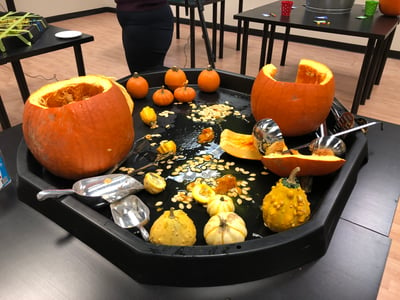
This Fall based bin is a great example of a seasonal sensory bin. Children have the opportunity to exploring the feel, smell, sound, taste, and anatomy of the pumpkin and its friend Gourd. This bin helps improve exploration and observational skills, while the scoops + spoons help improve motor skills via digging and dissecting pumpkins and gourds.
Materials used for this sensory bin:
- Active World Tray
- Pumpkins
- Gourds
- Scoops, tongs, and ladles
- Water
Forestry Friends Fun
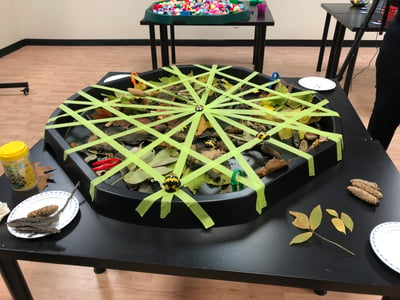
This nature based bin is great for exploring the feel, smell, and sounds of nature, while also including some game-based fun.
While the Honeybee Numbers Resource from Yellow Door helps improve observational and math/counting skills, the tape web encourages critical thinking skills and problem solving. If the goal is to find all the of the bees in order, then your child must learn to find them without disturbing the web.
Added bonus: Finding this bins materials will also get your child outside and exploring.
Materials used for this sensory bin:
- Active World Tray
- Leaves of all sorts, bark, pine cones, sticks, rocks
- Painters tape
- Gator Grabber Tweezers
- Honeybee Number Resources (Yellow Door)
Diggin’ in the Dirt

Children will explore the texture and smell of dirt with this bin. Build hand-eye-coordination and fine motor skills by having them Gator Grab the toys from the dirt, or inspire their imagination through digging and hands on play.
Materials used for this sensory bin:
- Bucket
- Dirt
- Toys, loose parts, tiny treasures
- Manuscript Letter Beads
- Gator Grabber Tweezers
- Sorting cups
A Situation of Sorts
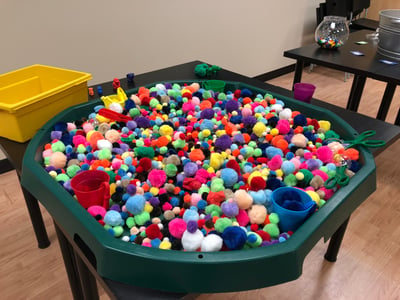
This amazingly colourful bin will get your child exploring multiple textures with hard and soft items bins. Make a game out of this one by adding in tweezers and coloured sorting cups, then have your child sort the items via colour and by whether the item is hard or soft. This will help improve their observational and motor skills!
This bin is also perfect for group games and sensory activities that will help build good sportsmanship, and present fair play opportunities.
Materials used for this sensory bin:
- Active World Tray
- Pom poms
- Jumbo Farm Counters
- Sorting cups: example Birds in a Nest Sorting Set
- Handy Scoopers
- Pipe cleaners
Hmm… But what about the mess?
I get it, you’re perhaps not thrilled about the idea of the contents inside of the bin making it outside of the bin. Luckily, many exploration bins are great for outside play…weather permitting.
Can’t make it outside? We recommend laying down a sheet or tarp under your exploration bins that include sand, water, [anything not floor friendly]. Your child may even be ready to help with keeping things organized with a new dust pan and hand brush 😉.


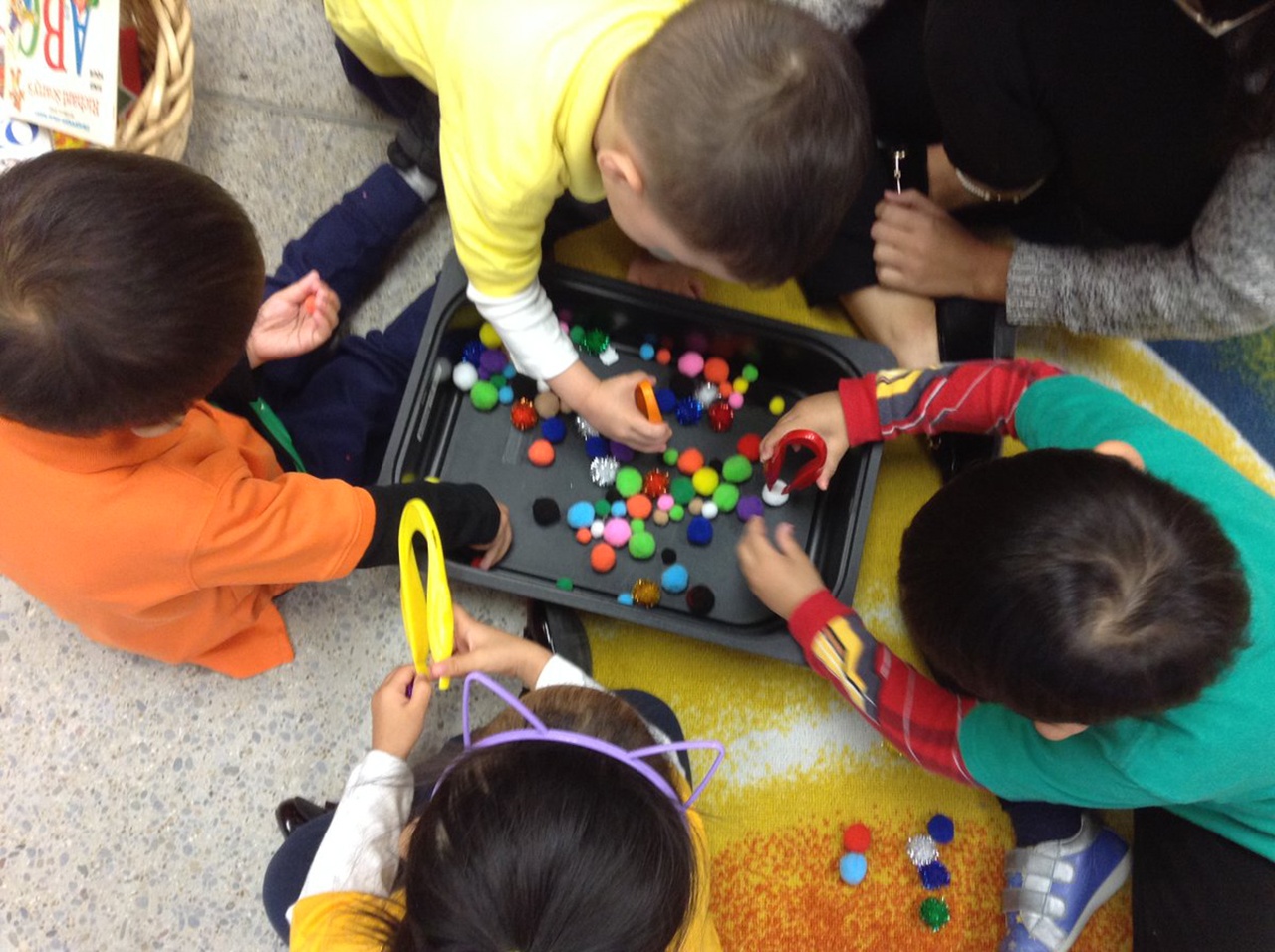

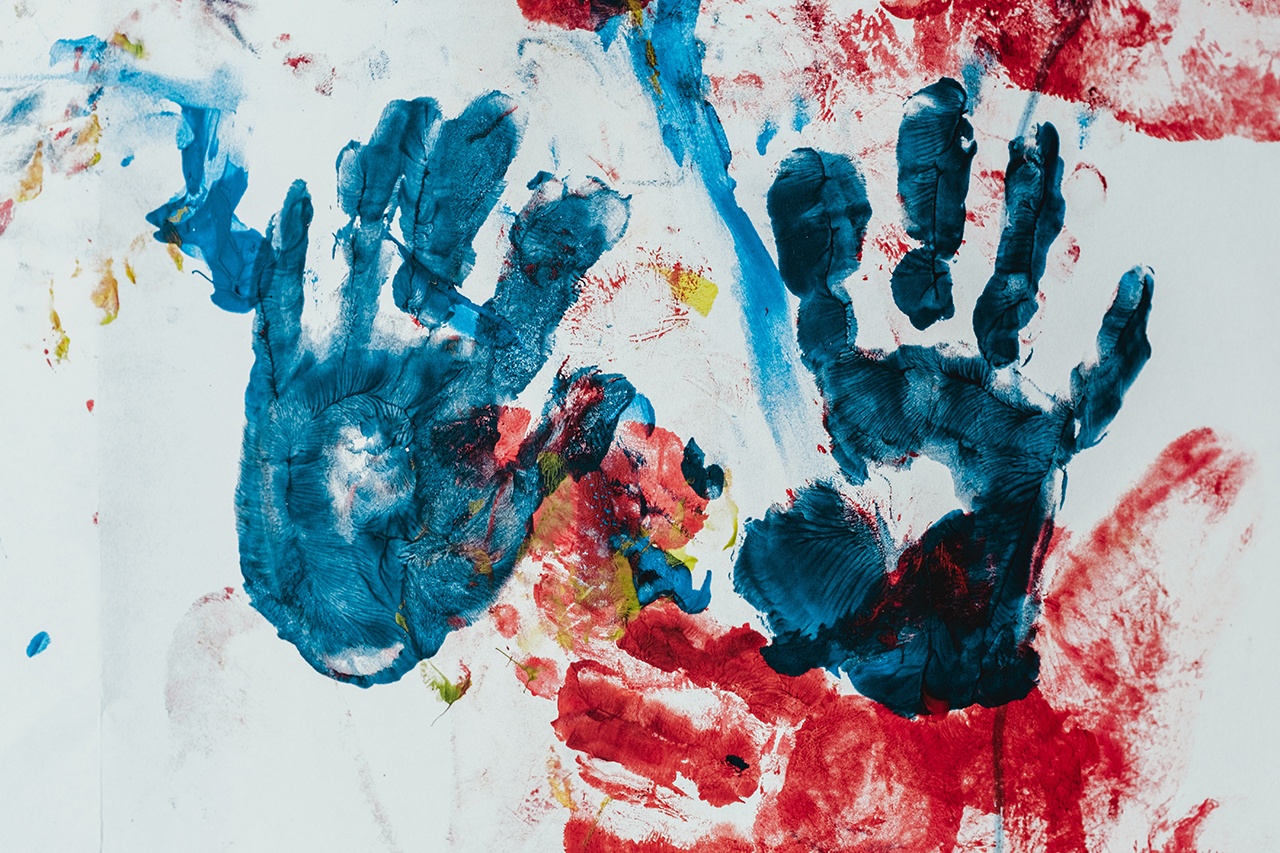

.png)
.jpg)
.png)